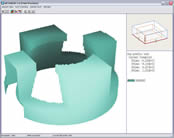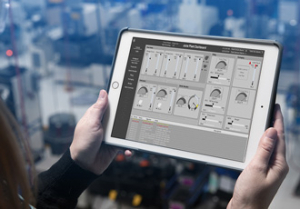Field Precision advances technology for finite-element mesh generation from 3D CAD data
15th February 2010
Source:
Field Precision LLC

Field Precision has achieved unprecedented reliability, speed and versatility in the direct generation of 3D conformal finite-element meshes using data exported from SolidWorks and other 3D CAD programs
Mesh generation is the most difficult and time-consuming task in finite-element simulations of electromagnetic and mechanical processes. Modern CAD programs like SolidWorks offer impressive visualization and model construction capabilities. The issue is how to transfer this information reliably and quickly to the finite-element program. Field Precision has developed a 3D data transfer system for its software that achieves unmatched reliability and speed (both in terms of computer and user time). The system supports all popular 3D CAD programs.
The critical issue in 3D data transfer is the choice of the medium. Semi-proprietary formats like IGES and STEP are verbose, laden with far more information than required for electromagnetic field solutions. Furthermore, these formats are complex and malleable, with the potential introduction of proprietary features. Direct interaction with the API of the CAD programs has its own drawbacks. Creation of the interface involves extensive labor for each CAD program, contributing to higher costs for the finite-element program. A version change by one CAD vendor necessitates additional work and an update of the client program. Most important, with a direct API connection the mesh conversion process is hidden from the FE program user. Although conversions may proceed smoothly for certain classes of solutions, the crash of a closed process for solutions outside the envelope leaves no recourse for repairs.
Field Precision has based its mesh-transfer technology on STL (stereo lithography) files, the basis of the 3D printing industry. An STL file consist simply of list of triangular facets. The facets define the surface of an object of any level of complexity. Each file represents an individual part of an assembly. STL files offer several advantages for 3D data transfer:
* The format is simple and immutable. Because the format is critical for an extensive base of expensive 3D printers, CAD vendors can not introduce modifications or proprietary features.
* Information exchange is highly efficient because the files carry essential geometrical information and nothing else.
* The importance of the 3D printing industry ensures that all 3D CAD programs include an STL export capability.
* A variety of third-party software is available for viewing, transforming and correcting STL objects.
The STL format is a perfect fit to Field Precision software. The mesh generation process in MetaMesh involves fabrication of a 3D assembly from a summation of solid parts. The program requires only shape information. All physical data is introduced in the subsequent finite-element solution programs.
Generation of STL files from a CAD program like SolidWorks is straightforward. Export from the Assembly space gives absolute facet coordinates that define the position and orientation of multiple parts, with a separate file for each part. Graphical preview features allow the user to control the quality of the surface representation. Unnecessary details that do not play a role in the electromagnetic solution and even entire parts may be suppressed. The resulting STL objects may then be inserted in the mesh space using the Field Precision interactive, graphical program Geometer.
Field Precision mesh programs have capabilities beyond the simple import of a CAD assembly:
* Geometer includes tools to introduce reflections, translations and stretching directly into STL files. In addition, the program includes a full-featured STL viewer with three-dimensional and precision projection displays.
* STL objects may be combined with native fundamental solids defined by parametric models.
* Users can introduce shifts and rotations of individual STL parts to perform perturbation analyses without the need to regenerate the CAD model.
* MetaMesh script directives enable global translations and rotations of entire STL assemblies.
* Geometer and MetaMesh feature complete user transparency, recording all features of the geometry in portable and accessible scripts.
As a result, Field Precision programs minimize user setup time and use computer resources efficiently. The multi-core version of MetaMesh can create a conformal mesh from a complex CAD assembly in minutes.
The critical issue in 3D data transfer is the choice of the medium. Semi-proprietary formats like IGES and STEP are verbose, laden with far more information than required for electromagnetic field solutions. Furthermore, these formats are complex and malleable, with the potential introduction of proprietary features. Direct interaction with the API of the CAD programs has its own drawbacks. Creation of the interface involves extensive labor for each CAD program, contributing to higher costs for the finite-element program. A version change by one CAD vendor necessitates additional work and an update of the client program. Most important, with a direct API connection the mesh conversion process is hidden from the FE program user. Although conversions may proceed smoothly for certain classes of solutions, the crash of a closed process for solutions outside the envelope leaves no recourse for repairs.
Field Precision has based its mesh-transfer technology on STL (stereo lithography) files, the basis of the 3D printing industry. An STL file consist simply of list of triangular facets. The facets define the surface of an object of any level of complexity. Each file represents an individual part of an assembly. STL files offer several advantages for 3D data transfer:
* The format is simple and immutable. Because the format is critical for an extensive base of expensive 3D printers, CAD vendors can not introduce modifications or proprietary features.
* Information exchange is highly efficient because the files carry essential geometrical information and nothing else.
* The importance of the 3D printing industry ensures that all 3D CAD programs include an STL export capability.
* A variety of third-party software is available for viewing, transforming and correcting STL objects.
The STL format is a perfect fit to Field Precision software. The mesh generation process in MetaMesh involves fabrication of a 3D assembly from a summation of solid parts. The program requires only shape information. All physical data is introduced in the subsequent finite-element solution programs.
Generation of STL files from a CAD program like SolidWorks is straightforward. Export from the Assembly space gives absolute facet coordinates that define the position and orientation of multiple parts, with a separate file for each part. Graphical preview features allow the user to control the quality of the surface representation. Unnecessary details that do not play a role in the electromagnetic solution and even entire parts may be suppressed. The resulting STL objects may then be inserted in the mesh space using the Field Precision interactive, graphical program Geometer.
Field Precision mesh programs have capabilities beyond the simple import of a CAD assembly:
* Geometer includes tools to introduce reflections, translations and stretching directly into STL files. In addition, the program includes a full-featured STL viewer with three-dimensional and precision projection displays.
* STL objects may be combined with native fundamental solids defined by parametric models.
* Users can introduce shifts and rotations of individual STL parts to perform perturbation analyses without the need to regenerate the CAD model.
* MetaMesh script directives enable global translations and rotations of entire STL assemblies.
* Geometer and MetaMesh feature complete user transparency, recording all features of the geometry in portable and accessible scripts.
As a result, Field Precision programs minimize user setup time and use computer resources efficiently. The multi-core version of MetaMesh can create a conformal mesh from a complex CAD assembly in minutes.
Similar articles
More from Field Precision LLC
- Field Precision announces new capability: 3D meshes from photographs 8th September 2011
- Field Precision announces Associates program for consultants and small businesses 16th August 2011
- Field Precision releases GamBet 3.0, multicore Monte Carlo software 2nd March 2011
- Field Precision Releases TriComp 7.0 for E&M fields and Electron Guns 22nd September 2010




 technology at Jacobs Vehicle Systems.JPG)







Write a comment
No comments